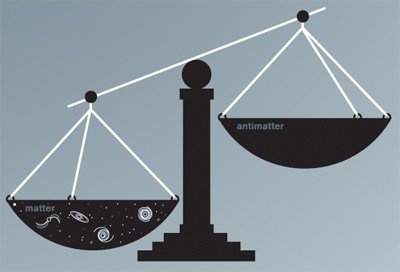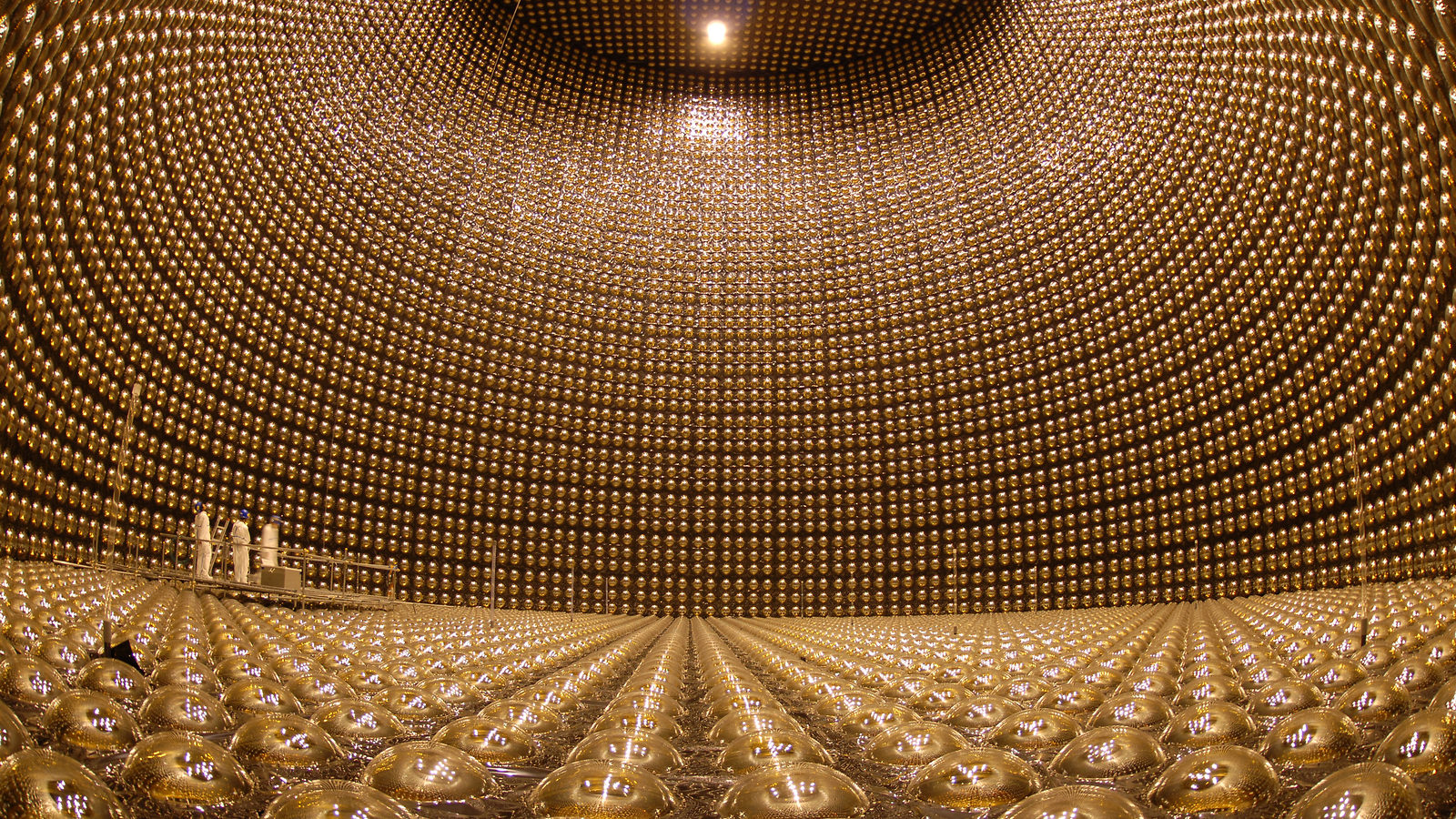In a critical advance in the study of neutrinos, the T2K (Tokai-to-Kamioka) collaboration today announced an exciting result that hones in on one important characteristic of the ghostly particles – the rate at which neutrinos and their antimatter counterparts, antineutrinos, oscillate between different flavours.This rate has significant implications for the predominance of matter over antimatter in our universe.
Matter, antimatter, and CP symmetry
Unlike many of their Standard Model siblings, neutrinos are somewhat aloof. They don’t interact via the electromagnetic force, which means that researchers can’t trap them in electrical or magnetic fields, nor do they interact via strong nuclear force, making it very difficult to rely on interaction with protons, neutrons, or nuclei to observe them. However, these weakly-interacting neutrinos may hold an all-important clue pointing to why, in our universe, matter predominates over antimatter.
To understand this, we’ll need to journey back to the Quark Epoch of the Big Bang.

In the first 10-12 to 10-16 seconds of our early universe, the four fundamental forces took shape in the way we see them today: gravity, electromagnetism, and the strong and weak nuclear forces.
It was also during this time that quarks, the constituent particles of protons and neutrons, began to form alongside their antimatter counterparts, antiquarks. In fact, quarks and antiquarks were created in almost perfectly-equal proportion—part of a wider phenomenon that physicists today call charge-parity (CP) symmetry. As with all matter-antimatter interactions, the vast majority of these quark-antiquark pairs immediately annihilated, removing both particles from existence and leaving behind only energy.
However, in a process that is not yet fully understood, CP symmetry was broken in the early universe. One quark in every billion quark-antiquark pair survived, leaving a surplus of quarks and a deficit of antiquarks. As the universe continued to cool, these quarks joined together to become protons and neutrons, which themselves bound into nuclei and further into atoms and molecules—the matter we see today.
While this violation of CP symmetry has been observed experimentally in certain quarks, it is not significant enough to account for the prevailing presence of matter over antimatter, indicating that there must have been some additional source of violation present in those early conditions.

Research has since turned to explore neutrinos, which were also created in vast amounts immediately after the Big Bang but which were long thought to not have mass at all. Since 2009, the T2K collaboration has been investigating whether neutrinos and their antimatter counterparts, antineutrinos, contribute significantly to the CP symmetry violation that tipped the balance in our early universe towards matter.
Neutrino oscillations
Like quarks and antiquarks, neutrinos and antineutrinos share many properties—including a unique phenomenon called ‘neutrino oscillation’.
We’ve observed that the neutrinos can ‘flip’, or oscillate, between one of three flavours: an electron neutrino can become a tau neutrino can become a muon neutrino. This means that neutrinos experience time, and thus travel at less than the speed of light – which requires that neutrinos have mass. These revelations were established in a series of Nobel Prize-winning experiments led by Dr. Takaaki Kajita and Dr. Art McDonald at Super-Kamiokande and the Sudbury Neutrino Observatory [SNO] respectively. In 2011, the T2K collaboration provided the first glimpse of muon neutrinos transforming into electron neutrinos, which they then confirmed in 2014. This confirmation established the oscillation channel where the collaboration could search for CP violation.
If the rate at which antimatter neutrinos oscillate between flavours is significantly different than this oscillation rate in matter neutrinos, this would represent one of the most significant instances of CP symmetry violation yet observed in our universe—and perhaps account for the violation necessary to produce our matter world.
Critical restrictions of neutrino oscillation phase
Now, with results published today in the prestigious journal Nature, T2K researchers have have made an important first step in the comparison of neutrino and antineutrino oscillation.
The results address a parameter called the ‘δcp phase’, a value that governs asymmetry in neutrino oscillation and which takes a value of from -180º to 180º. If the δcp takes one of the values of, ±180º or 0º, neutrinos and antineutrinos oscillate to different flavours with the same probability, indicating that matter and antimatter behave in the same way. If the δcp phase takes any other value it follows that the oscillation probability is different for neutrinos and antineutrinos, indicating that matter and antimatter do not behave in the same way, thus violating CP symmetry.
Today, the collaboration is announcing that nearly half the values for δcp (in grey, below) are excluded, providing the strongest constraint yet in our understanding of whether or not neutrinos and antineutrinos behave similarly.
These results build on previous exclusionary limits established by the T2K collaboration, and add more precise guardrails for navigating future investigations of neutrino oscillation.

“These results are a significant step towards our understanding of the fundamental particles called neutrinos and how they relate to important questions in our understanding of the universe and the particles and forces that define its evolution.” said Dr. Mark Hartz, TRIUMF’s corresponding author on the Nature publication and a key contributor to the optical transition radiation (OTR) detector, developed by the TRIUMF, the University of Toronto and York University. “We now look forward to making even more precise measurements of neutrino oscillations with upgrades of our experimental apparatus, including the upgrade of the neutrino beam intensity and new neutrino detectors such as the next-generation Hyper-Kamiokande detector.”
“Neutrino transformations are a beautiful way to study the matter-antimatter asymmetry in the universe," said Dr. Sampa Bhadra, York University Faculty of Science York University Faculty of Science, TRIUMF Affiliate Scientist, and project leader for the OTR detector. "What can be more exciting than studying a particle that may hold the clue to our very existence?"
T2K, TRIUMF, and Canada

(image: the Super-K detector; the T2K collaboration)
The Japan-based T2K is one of TRIUMF’s major international collaborations, with TRIUMF scientists, engineers and technicians providing expertise and material contributions from conception, through design, construction, operation, data collection and data analysis. It is the first experiment to artificially generate neutrinos and explore how they change flavour as they travel.
In T2K, an intense beam of muon neutrinos is created at the Japan Proton Accelerator Research Complex (JPARC) on Japan’s east coast and sent 295 km through the earth to Super-K in western Japan. Before it leaves J-PARC, the neutrino beam is characterized using the Near Detector 280 (ND280), located 280 meters from the beam’s source. The ND280 and Super-K enable a before-and-after oscillation measurement of the muon neutrino beam.
The T2K international collaboration involves approximately 500 scientists and engineers from 63 institutions in 11 countries. The Canada T2K group involves TRIUMF and the University of Alberta, University of British Columbia, University of Regina, University of Toronto, University of Victoria, University of Winnipeg and York University.
The Canadian effort provided some of the most challenging and critical detectors of the project: the time projection chamber (TPC), the fine-grained calorimeter (FGD), the OTR detector, as well as the development of the Intermediate Water Cerenkov Detector (IWCD), which will measure the properties of neutrino interactions and bring a necessary reduction in the uncertainties in a largely model-independent way. Canada also contributed to the success of T2K through key leadership roles.
TRIUMF and Canadian university collaborators are currently participating in the proposal and detailed planning for a successor to the T2K experiment, Hyper-Kamiokande, a neutrino detector 20-times the volume of Super-K. Hyper-Kamiokande will provide greater sensitivity and remove key uncertainties from current measurements, as well as searching for supernova neutrinos and proton decay.
Congratulations to the T2K collaboration!
You can watch Nature's video on this results, 'Cracking the antimatter mystery: A three minute guide', here.
